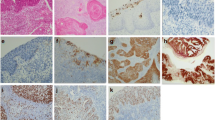Abstract
Objective
This study was designed to evaluate the immunohistochemical expression of proliferating cell nuclear antigen (PCNA) and p53 protein expression in preneoplastic and neoplastic lesions in uterine cervix.
Study Design
A total of 36 cervical biopsies were subjected for immunostaining and the results were correlated with different prognostic parameters. Bivariate and multivariate statistical analyses were done using “STATA” software.
Results
PCNA labeling index and p53 expression increased with increasing severity of CIN lesions. PCNA labeling index was maximum (46.0) carcinoma cervix with intense positive staining. In bivariate statistical analysis, p53 and PCNALI were found to be insignificant (0.4184 and 0.4328, respectively). Menopausal stage was significantly associated with CA and CIN groups (P < 0.166 and P < 0.049), respectively.
Conclusion
These markers may be of greater importance in low-grade CIN lesions showing high proliferative index. This will place the low-grade lesions in higher grade indicating the utility of proliferative markers in decision making for intervention. This method is simple and cost effective and may be useful in developing countries where HPVDNA testing is still out of reach because of high cost.
Similar content being viewed by others
References
Globocan 2008 All Cancers (excluding non-melanoma skin cancer) Incidence and Mortality Worldwide in 2008.
WHO/ICO Information Centre on HPV and Cervical Cancer. Available from http://www.who.int/hpvcentre. Cited May 5 2009.
Stoler MH, Schiffman M. Interobserver reproducibility of cervical cytologic and histologic interpretations: realistic estimates from the ASCUS-LSIL Triage Study. JAMA. 2001;285:1500–5.
Anttila A, Pukkala E, Soderman B, et al. Effect of organized screening on cervical cancer incidence and motality in finland, 1963–1995: recent increase in cervical cancer incidence. Int J Cancer. 1999;83:59–65.
Negri G, Vittadello F, Romano F, et al. P16INK4a expression and progression risk of low-grade intraepithelial neoplasia of the cervix uteri. Virchows Arch. 2004;445(6):616–20.
McCluggage WG, Walsh MY, Thornton CM, et al. Inter and intra-observer variation in the histopathological reporting of cervical squamous intraepithelial lesions using a modified Bethesda grading system. Br J Obstet Gynaecol. 1998;105(2):206–10.
Chi CH, Rubio CA, Lagerlof B. The frequency and distribution of mitotic figures in dysplasia and carcinoma in situ. Cancer. 1977;39(3):1218–23.
Herbsleb M, Knudsen UB, Orntoft TF, et al. Telomerase activity, MIB-1, PCNA, HPV16 and p53 as diagnostic markers for cervical intraepithelial neoplasia. APMIS. 2001;109(9):607–17.
Lool ML, Dali AZ, Ali SA, et al. Expression of p53, bcl2 and Ki-67 in cervical intraepithelial neoplasia and invasive squamous cell carcinoma of the uterine cervix. Anal Quant Cytol Histol. 2008;30(2):63–70.
Goel MM, Mehrotra A, Singh U, et al. MIB-1 and PCNA immunostaining as a diagnostic adjunct to cervical pap smear. Diagn Cytopathol. 2005;33:15–9.
Holem R, Skomedal H, Helland A, et al. Immunohistochemical analysis of p53 protein overexpression in normal, premalignant and malignant tissues of the cervix uterine. J pathol. 1993;169:21–6.
Turcuo L, Tezcan S, Kaygusuz G, et al. The role of p53, bcl2 and ki-67 in premalignant cervical lesions and cervical cancer. Eur J Gynaecol Oncol. 2007;28(4):290–3.
Cardillo MR, Stamp GW, Pignatelli MN, et al. Immunohistochemical analysis of p53 oncopotein and proliferating cell nuclear antigen (PCNA) in the cervix uteri. Eur J Gynaecol Oncol. 1993;14(6):484–90.
Wang JL, Zheng BY, Li XD, et al. Predictive significance of the alteration of p161NK4A, p14ARF, p53 and proliferative cell nuclear antigen expression in the progression of cervical cancer. Clin Cancer Res. 2004;10(7):2407–14.
Heatley MK. What is the value of proliferation markers in the normal and neoplastic cervix? Histol Histopathol. 1998;13(1):249–54.
Astudillo H, Perez M, Silva J, et al. p53, Bcl-2, PCNA expression and apoptotic rates during cervical tumorigenesis. Ann N Y Acad Sci. 2003;1010:771.
Maeda MY, Simoes M, Wakamatsu A, et al. Relevance of the rates of PCNA, Ki-67 and p53 expression according to the epithelial compartment in cervical lesion. Gynecol Obstet Fertile. 2000;28(1):44–50.
Hall PA, Woods AL. Immunohistochemical markers of cellular proliferation: achievements, problems and prospects. Cell Tissue Kinet. 1990;23:505–22.
Acknowledgment
This study was financially supported by Indian Council of Medical Research, New Delhi.
Author information
Authors and Affiliations
Corresponding author
Rights and permissions
About this article
Cite this article
Madhumati, G., Kavita, S., Anju, M. et al. Immunohistochemical Expression of Cell Proliferating Nuclear Antigen (PCNA) and p53 Protein in Cervical Cancer. J Obstet Gynecol India 62, 557–561 (2012). https://doi.org/10.1007/s13224-012-0180-6
Received:
Accepted:
Published:
Issue Date:
DOI: https://doi.org/10.1007/s13224-012-0180-6




